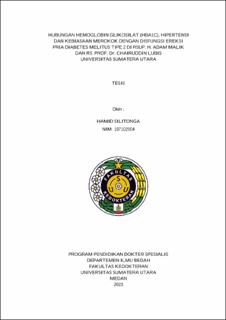Hubungan Hemoglobin Glikosilat (HBA1C), Hipertensi dan Kebiasaan Merokok dengan Disfungsi Ereksi Pria Diabetes Melitus Tipe 2 di RSUP. H. Adam Malik dan Rs. Prof. Dr. Chairuddin Lubis Universitas Sumatera Utara

Date
2023Author
Silitonga, Hamid
Advisor(s)
Warli, Syah Mirsya
Prapiska, Fauriski Febrian
Metadata
Show full item recordAbstract
Background: Type 2 Diabetes Mellitus (T2DM), one of the most common metabolic disorders, is a widespread disease affecting millions worldwide with erectile dysfunction (ED) emerging as a growing concern among diabetic men. Various factors, such as glycated haemoglobin (HbA1c), hypertension, and smoking, have been linked to ED in men with diabetes. The intricate nature of this relationship, along with the psychological impact of ED, warrants further analysis. This study aims to explore the association between these factors and ED in type 2 diabetic men, potentially serving as a guide for the importance of diagnosing, treating, and researching ED in this population.
Methods: This cross-sectional study was conducted on male T2DM patients aged 19 and above, admitted to Haji Adam Malik General Hospital and Prof. dr. Chairuddin Lubis Universitas Sumatera Utara Hospital from January to June 2023. Consecutive sampling was employed, with data collected through blood examination results and a questionnaire adapted from the International Index of Erectile Function-5 (IIEF-5). Patients' ED status was determined through interviews, while HbA1c, hypertension, and smoking status served as independent variables for analysis. Descriptive data is presented using means, medians, or percentages. Chi-square tests were employed to examine the relationships between variables, followed by multivariate analysis through multiple logistic regression.
Result: This study investigated the prevalence and severity of ED in relation to various factors. Among T2DM individuals, those with HbA1c levels between 9.5% and 10.9% were 6.21 times more likely to experience severe ED, while those with HbA1c levels = 11% were 5.56 times more likely, compared to T2DM patients with HbA1c levels <8%. Hypertension and smoking habits exhibited strong associations with ED (p<0.006 and p<0.001, respectively). Age significantly impacted ED, with higher prevalence and severity observed in older age groups (p<0.001). Education level did not show a significant correlation with ED (p=0.457). Conversely, the duration of type 2 diabetes significantly correlated with both ED prevalence and severity (p<0.001). A family history of diabetes did not significantly relate to ED prevalence or severity.
Conclusion: This study highlights a significant relationship between HbA1c values and the severity of ED. It also underscores significant associations between hypertension, smoking habits, and the prevalence and severity of ED. Age and the duration of T2DM were found to be significant factors affecting ED, while educational level and family history of diabetes did not exhibit a significant correlation with ED prevalence or severity.
Collections
- Master Theses [204]
